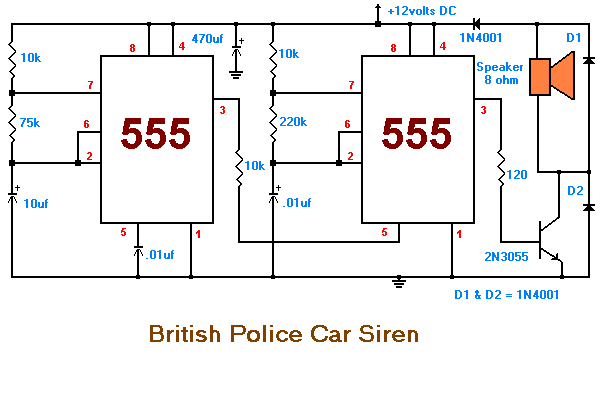
UM3561 Siren Generator Design

The UM3561 is a versatile ROM integrated circuit capable of generating multiple siren tones, including those that simulate police sirens, ambulance sirens, fire brigade sirens, and machine gun sounds. This low-power, 8-pin IC operates down to 2.4 volts and is designed for cost-effective use in toy applications. The UM3561 features an integrated oscillator and tone selection pins, allowing for the easy construction of a siren generator with minimal external components. Only a single external resistor and a speaker driver transistor are required to create a basic siren generator. The internal oscillator circuit's frequency is modulated by an external resistor connected to OSC1 (Pin 7) and OSC2 (Pin 8), with a 220k ohm resistor yielding satisfactory performance. The generated oscillations are routed to a control circuit that functions based on tone selection through SEL1 (Pin 6) and SEL2 (Pin 1). This control circuit directs the signal to an address counter and subsequently to the ROM, with the resulting tone pulses available at output pin 3. Due to the weak nature of the sound produced, an amplifier is necessary to achieve a louder output, which can be accomplished using a single NPN transistor.
The UM3561 integrated circuit is engineered to facilitate the generation of various siren tones, making it an ideal choice for applications in toys and other low-power devices. The design incorporates an internal oscillator that is adjustable through external components, specifically resistors, allowing for flexibility in tone generation. The operational voltage range of 2.4 volts to 5 volts makes the UM3561 suitable for battery-powered devices, ensuring extended operational life.
In constructing a siren generator using the UM3561, the primary external component required is a resistor connected to the oscillator pins (Pin 7 and Pin 8). The recommended value of 220k ohms enables the oscillator to produce a frequency that is well within the audible range for sirens. The tone selection pins (SEL1 and SEL2) permit the user to choose between different sound outputs, which are then processed through an internal control circuit. This circuit effectively manages the tone selection and directs the signal to the ROM, where the stored sound patterns are accessed.
Output pin 3 provides the generated tone pulses, which can be further amplified to enhance the sound output. The use of an NPN transistor as a speaker driver is a common practice, as it allows for sufficient amplification to drive a small speaker, making the siren audible at a desirable volume. The simplicity of the circuit design, combined with the low component count, makes the UM3561 an efficient solution for generating siren sounds in various electronic projects. Overall, the UM3561 is a practical and economical choice for creating sound effects in toy applications and similar devices.UM3561 is an excellent ROM IC that can generate Multi siren tones simulating Police siren, Ambulance siren, Fire brigade siren and Machine gun sound. This 8 pin low power IC can work down to 2. 4 volts. The UM 3561 is a low cost siren generator designed for use in toy applications. The IC has an inbuilt oscillator and tone selection pins. It is easy to make a siren generator with only a few external components. Only one external resistor and a speaker driver transistor are sufficient to make a simple siren generator. Inside the IC, there is an oscillator circuit and the frequency of oscillations is controlled by the external resistor connected to OSC 1(Pin 7) and OSC2 (Pin 8).
A 220 K resistor will give satisfactory results. The oscillations thus generated will be then transferred to a control circuit which function based on the tone selection through the connections of SEL 1 (Pin 6) and SEL2 (Pin 1). The control circuit passes the signal to an address counter and then to the ROM. The tone pulses thus generated will be available from the output pin 3. Since the sound is weak, an amplifier is necessary to get loud sound. A single NPN transistor will amplify the sound. 🔗 External reference
The UM3561 integrated circuit is engineered to facilitate the generation of various siren tones, making it an ideal choice for applications in toys and other low-power devices. The design incorporates an internal oscillator that is adjustable through external components, specifically resistors, allowing for flexibility in tone generation. The operational voltage range of 2.4 volts to 5 volts makes the UM3561 suitable for battery-powered devices, ensuring extended operational life.
In constructing a siren generator using the UM3561, the primary external component required is a resistor connected to the oscillator pins (Pin 7 and Pin 8). The recommended value of 220k ohms enables the oscillator to produce a frequency that is well within the audible range for sirens. The tone selection pins (SEL1 and SEL2) permit the user to choose between different sound outputs, which are then processed through an internal control circuit. This circuit effectively manages the tone selection and directs the signal to the ROM, where the stored sound patterns are accessed.
Output pin 3 provides the generated tone pulses, which can be further amplified to enhance the sound output. The use of an NPN transistor as a speaker driver is a common practice, as it allows for sufficient amplification to drive a small speaker, making the siren audible at a desirable volume. The simplicity of the circuit design, combined with the low component count, makes the UM3561 an efficient solution for generating siren sounds in various electronic projects. Overall, the UM3561 is a practical and economical choice for creating sound effects in toy applications and similar devices.UM3561 is an excellent ROM IC that can generate Multi siren tones simulating Police siren, Ambulance siren, Fire brigade siren and Machine gun sound. This 8 pin low power IC can work down to 2. 4 volts. The UM 3561 is a low cost siren generator designed for use in toy applications. The IC has an inbuilt oscillator and tone selection pins. It is easy to make a siren generator with only a few external components. Only one external resistor and a speaker driver transistor are sufficient to make a simple siren generator. Inside the IC, there is an oscillator circuit and the frequency of oscillations is controlled by the external resistor connected to OSC 1(Pin 7) and OSC2 (Pin 8).
A 220 K resistor will give satisfactory results. The oscillations thus generated will be then transferred to a control circuit which function based on the tone selection through the connections of SEL 1 (Pin 6) and SEL2 (Pin 1). The control circuit passes the signal to an address counter and then to the ROM. The tone pulses thus generated will be available from the output pin 3. Since the sound is weak, an amplifier is necessary to get loud sound. A single NPN transistor will amplify the sound. 🔗 External reference





